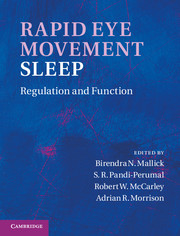Book contents
- Frontmatter
- Contents
- Contributors
- Preface
- Acknowledgments
- Organization
- Section I Historical context
- Section II General biology
- Section III Neuronal regulation
- Section IV Neuroanatomy and neurochemistry
- 19 Aminergic influences in the regulation of basic REM sleep processes
- 20 REM sleep regulation by cholinergic neurons: highlights from 1999 to 2009
- 21 GABAergic modulation of REM sleep
- 22 Glutamatergic regulation of REM sleep
- 23 The role of tuberomammillary nucleus histaminergic neurons, and of their receptors, in the regulation of sleep and waking
- 24 Hypocretinergic system: role in REM-sleep regulation
- 25 Neuropeptides and REM sleep
- 26 Adenosine and glycine in REM-sleep regulation
- 27 Changes in neurotransmitter levels in relation to REM sleep for its regulation
- 28 Pontine areas inhibiting REM sleep
- 29 Neuronal models of REM-sleep control: evolving concepts
- Section V Functional significance
- Section VI Disturbance in the REM sleep-generating mechanism
- Index
- Plate section
- References
20 - REM sleep regulation by cholinergic neurons: highlights from 1999 to 2009
from Section IV - Neuroanatomy and neurochemistry
Published online by Cambridge University Press: 07 September 2011
- Frontmatter
- Contents
- Contributors
- Preface
- Acknowledgments
- Organization
- Section I Historical context
- Section II General biology
- Section III Neuronal regulation
- Section IV Neuroanatomy and neurochemistry
- 19 Aminergic influences in the regulation of basic REM sleep processes
- 20 REM sleep regulation by cholinergic neurons: highlights from 1999 to 2009
- 21 GABAergic modulation of REM sleep
- 22 Glutamatergic regulation of REM sleep
- 23 The role of tuberomammillary nucleus histaminergic neurons, and of their receptors, in the regulation of sleep and waking
- 24 Hypocretinergic system: role in REM-sleep regulation
- 25 Neuropeptides and REM sleep
- 26 Adenosine and glycine in REM-sleep regulation
- 27 Changes in neurotransmitter levels in relation to REM sleep for its regulation
- 28 Pontine areas inhibiting REM sleep
- 29 Neuronal models of REM-sleep control: evolving concepts
- Section V Functional significance
- Section VI Disturbance in the REM sleep-generating mechanism
- Index
- Plate section
- References
Summary
Summary
Rapid eye movement (REM) sleep is a behavioral state initiated and maintained by the interaction of multiple neurotransmitters, including acetylcholine. Numerous studies confirm that cholinergic transmission contributes to the regulation of REM sleep. Cholinergic signaling in the basal forebrain modulates the cortical activation that occurs during REM sleep. It is also well documented that cholinergic transmission in the pontine reticular formation plays a role in REM-sleep generation and maintenance. This chapter highlights evidence supporting that acetylcholine regulates REM sleep and focuses on the mechanisms that regulate cholinergic transmission within arousal-regulating brain regions. The chapter also considers how other arousal-regulating neurotransmitters, such as hypocretin, GABA, adenosine, and opioids modulate both cholinergic signaling and REM sleep. A greater understanding of how neurotransmitter interactions regulate REM sleep will further clarify the role of cholinergic transmission in REM-sleep generation. Employing new analytical techniques will facilitate understanding the effects of multiple neurotransmitter interactions on physiologically relevant time scales. Capillary electrophoresis and biosensors, which can quantify neurochemical changes on the order of seconds, will allow insights that could not be achieved with more conventional sampling techniques.
- Type
- Chapter
- Information
- Rapid Eye Movement SleepRegulation and Function, pp. 194 - 205Publisher: Cambridge University PressPrint publication year: 2011



